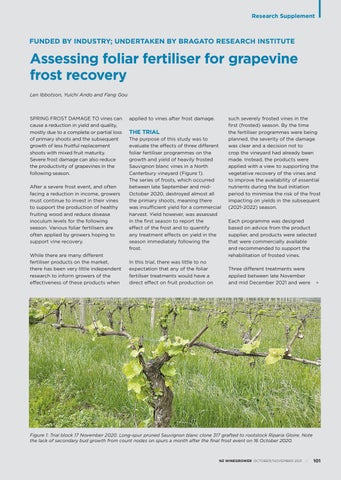Research Supplement
FUNDED BY INDUSTRY; UNDERTAKEN BY BRAGATO RESEARCH INSTITUTE
Assessing foliar fertiliser for grapevine frost recovery Len Ibbotson, Yuichi Ando and Fang Gou
SPRING FROST DAMAGE TO vines can cause a reduction in yield and quality, mostly due to a complete or partial loss of primary shoots and the subsequent growth of less fruitful replacement shoots with mixed fruit maturity. Severe frost damage can also reduce the productivity of grapevines in the following season. After a severe frost event, and often facing a reduction in income, growers must continue to invest in their vines to support the production of healthy fruiting wood and reduce disease inoculum levels for the following season. Various foliar fertilisers are often applied by growers hoping to support vine recovery. While there are many different fertiliser products on the market, there has been very little independent research to inform growers of the effectiveness of these products when
applied to vines after frost damage.
THE TRIAL The purpose of this study was to evaluate the effects of three different foliar fertiliser programmes on the growth and yield of heavily frosted Sauvignon blanc vines in a North Canterbury vineyard (Figure 1). The series of frosts, which occurred between late September and midOctober 2020, destroyed almost all the primary shoots, meaning there was insufficient yield for a commercial harvest. Yield however, was assessed in the first season to report the effect of the frost and to quantify any treatment effects on yield in the season immediately following the frost. In this trial, there was little to no expectation that any of the foliar fertiliser treatments would have a direct effect on fruit production on
such severely frosted vines in the first (frosted) season. By the time the fertiliser programmes were being planned, the severity of the damage was clear and a decision not to crop the vineyard had already been made. Instead, the products were applied with a view to supporting the vegetative recovery of the vines and to improve the availability of essential nutrients during the bud initiation period to minimise the risk of the frost impacting on yields in the subsequent (2021-2022) season. Each programme was designed based on advice from the product supplier, and products were selected that were commercially available and recommended to support the rehabilitation of frosted vines. Three different treatments were applied between late November and mid December 2021 and were
Figure 1: Trial block 17 November 2020. Long-spur pruned Sauvignon blanc clone 317 grafted to rootstock Riparia Gloire. Note the lack of secondary bud growth from count nodes on spurs a month after the final frost event on 16 October 2020.
NZ WINEGROWER OCTOBER/NOVEMBER 2021 // 101
